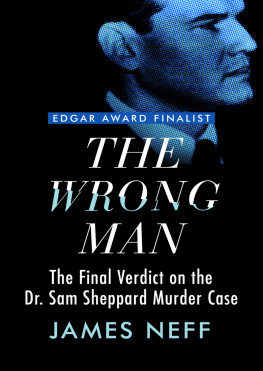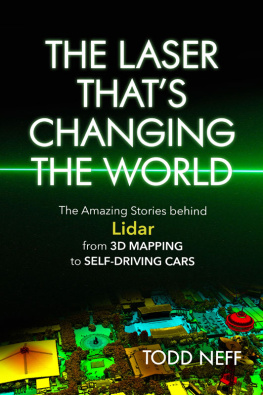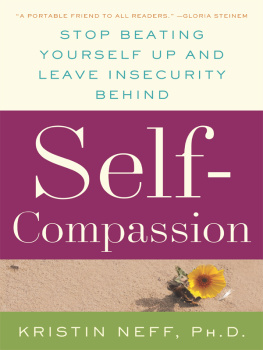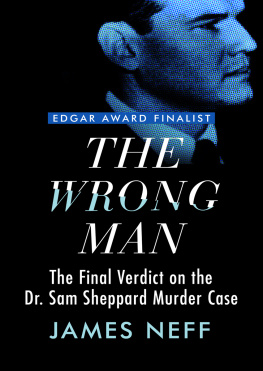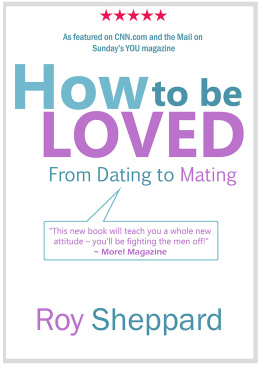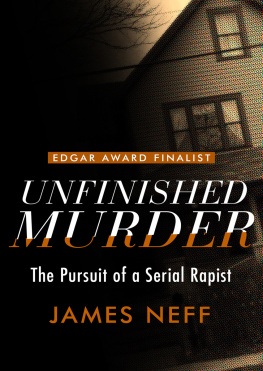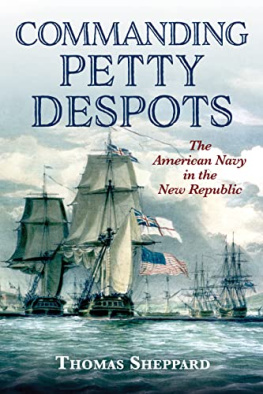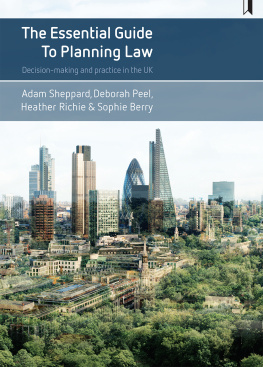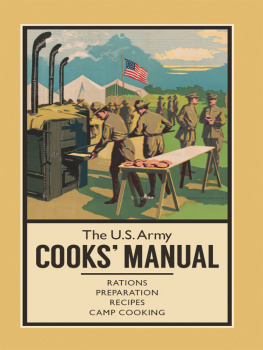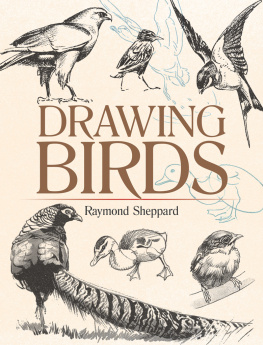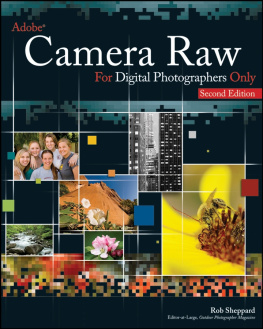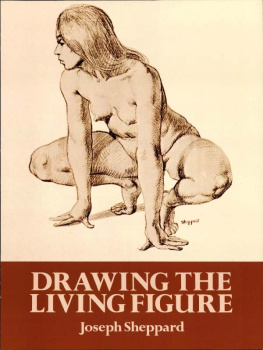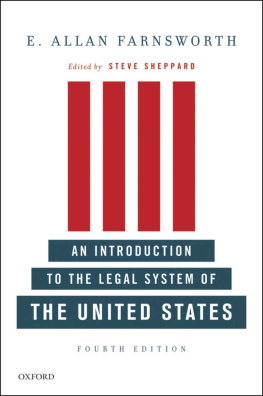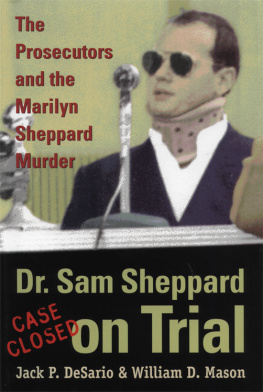The Wrong Man
The Final Verdict on the Dr. Sam Sheppard Murder Case
James Neff

For Chris and Jamie
Chase after the truth like all hell and youll free yourself, even though you never touch its coattails.
CLARENCE DARROW
ACKNOWLEDGMENTS
I grew up in Cleveland in the 1950s and 1960s, where I learned that Dr. Sam Sheppard, despite his 1966 acquittal, was guilty of murdering his pregnant wife. The farther I moved away from Clevelanda student at the University of Notre Dame, working as a reporter in Chicago and Austin, Texasthe more likely it was that people, if they were familiar with the case, felt that Sam Sheppard was innocent. Journalists are drawn to conflict, and I became fascinated with the idea that this famous murder had not been solved. I began investigating this primal American drama ten years ago. Nearly everything I thought I knew about the case would turn out to be wrong.
Five years ago, I benefited from the judgment and faith of Ann Godoff at Random House, who saw a book in my early research. No author ever had a more patient editor. Whenever I thought my research was done, the Sheppard case would take another twist that delayed its conclusion: three times, important physical evidence was discovered and sent off to be DNA tested; twice, bodies were exhumed and studied for clues; when the Ohio Supreme Court ruled, in late 1998, that the estate of Dr. Sheppard would indeed be able to go to trial with a wrongful imprisonment lawsuit, the story galloped off in new directions.
I am most appreciative to my friend and research associate Joan Fechter for her tremendous contributions, both professional and personal. Over the past five years, she managed, despite her own familys demands, to meet every challenge, from tracking down long-lost jurors from the 1954 trial to getting my sons to school during family emergencies. Her critical reading of the manuscript improved it considerably.
I especially want to thank editor Ruth Coughlin, who joined this project at the last minute under a fierce deadline. She did an excellent job of tightening and sharpening the book, while remaining calm, funny, and available at all hours. I am lucky to have Esther Newberg of ICM as an agent, supporter, and friend. Thanks also to Margaret Wimberger, Sarajane Herman, Lauren Field, Bonnie Thompson, Chuck Antony, Sybil Pincus, Sarah DImperio, and Sunshine Lucas of Random House for making The Wrong Man a better book.
My love and appreciation go to my parents, Dorothy and Charley Neff of Cleveland, who were of great support and comfort over these years and spent hours doing records research at the Western Reserve Historical Society. My love and appreciation also to my six brothers and sisters, notably Joe for his insightful reading and comments on an early draft. Thanks also to Dr. Mark Mayer of the Cleveland Clinic for deciphering medical records and overall support; Linda and Bob House and the Lesko family for their recollections; Barb Vanarsdall for random acts of kindness; G. Boots; Dan Davis; Mark Naymik; Marian Marzynski; Peter Myers, who transferred old Dictabelts to audiocassette; and Don Ray, who tracked down vital records in California.
My gratitude goes to Investigative Reporters and Editors as well as the Society of Professional Journalists (SPJ), both of which came through with outrage and letters of protest when prosecutors tried to commandeer my research. Thanks to Plain Dealer executive editor Doug Clifton and editorial page director Brent Larkin for the editorial backup. I was blessed by the generous, aggressive work of First Amendment lawyer David Marburger of Baker & Hostetler, who defeated the prosecutors efforts to obtain my work product and to compel me to testify about my methods. David and his associate Kyle Fleming put in many hours without compensation. Thanks also to the SPJs Legal Defense Fund, which provided a small grant for legal expenses.
Members of the Sheppard and Reese families, some of whom have been hounded by journalists over the years, generously granted interviews: Sam Reese Sheppard, Stephen Sheppard, Betty Sheppard, Jan Sheppard Duval, Carol Leimbach, Dorothy Sheppard, Margaret Cellini, and Melissa Bevilacqua.
My thanks go to all who agreed to be interviewed, especially Terry Gilbert and Carmen Marino, and Jean Disbro Anderson, Harvey Aronson, F. Lee Bailey, Elizabeth Balraj, Howard Barrish, Doris ODonnell Beaufait, Pat Bogar, Tom Brady, George Carr, Marilyn Cassidy, Jim Chapman, William Joseph Corrigan, Charles Cowan, George Cowan, Mary Cowan, Richard Dalrymple, John Davis, A. Steven Dever, Henry Dombrowski, David Doughten, Fred Drenkhan, Kathy Wagner Dyal, John Eberling, Richard Eberling, Barton Epstein, Kurt Fensel, Anne Foote, Harry Franken, Dan Gaul, Roberta Gerber, Norm Gevitz, Andre Gibaldi, Otto and Beverly Graham, Peter Gray, Helen Hall, Leonard Harrelson, Buck Harris, Virginia Haskett, Obie Henderson, Pamela Henry, Michael Howard, Jay Hubach, Roy Huggins, Leah Jacoby, George Jindra, David Kerr, Marion Koloski, Vince Kremperger, William Lamb, Kathy Levine, William V. Levy, Jane Lowenthal, Linda Luke, Lois Mancini, William D. Mason, Timothy J. McGinty, Janet McGlothin, Doug McQuigg, Dick Moore, Phyllis Moretti, Beatrice Orenstein, Ralph Perk, John W. Reese, Faith Corrigan Refnes, Oliver Schroeder, Jessie Dill Seymour, Chester M. Southam, Leo Spellacy, Victor Strecher, Alvin Sutton, Mohammad Tahir, Emanuel Tanay, Bill Tanner, James Tompkins, Andrew Tuney Jr., Walter Vallee, Daniel Volkema, Cyril Wecht, Harold Wilbert, James Willard, William Wiltberger, Robert White, Toby Wolson, Jim Wooley, Chalmers Wylie, and Dave Zimmerman.
Many in the forensic community provided advice, services, and consultation, for which I am particularly grateful: Norah Rudin, Keith Inman, Lisa Calandro, Robin Cotton, Kathryn Colombo, Chuck Morton, John Murdock, Ed Blake, Mitchell Holland, Rebecca Reynolds, Michael Baden, Leonard Harrelson, Robert K. Ressler, and John E. Douglas, among others.
I want to thank Ohio State Universitys School of Journalism, where I directed the Kiplinger Reporting Program, from 1994 to 1999, and enjoyed research support, especially the hard work of Debra Baer and Ben Zeng, and also of Susan Glaser, Nan Wang, Sarah Wendell, and Angela Chundrlek.
Others who helped were Maureen Hays, Russ Mussara, John Caniglia, Tom Mudd, Carlos Davis, Darlene Brown, John OBrien, Jim McCann, James Monroe, Dennis Kucinich, Janet Holmes, Miriam Holmes, Charles Stuart, Nick Gatz, Arthur and Shirley Cooper, Timothy M. Schaefer, Donald G. Dutton, and especially Fredric Dannen.
Special collections, archives, and libraries held many treasures about the Sheppard case and its times. My thanks go to the following institutions and employees: Judy Lueders, Frank Baker, and Walter D. Morrill at Hanover College; Danielle Bickers at the Ohio Medical Board; Joanne Drake at the Ronald Reagan Presidential Library; Angie M. Burton at the Osteopathic Medical Board of California; Dorothy Duffy Knaus and Linda Long at the University of Oregons Knight Library (Margaret Parton papers); Bill Bowers at Northeastern University (Samuel H. Sheppard papers); Michael McCormack and Ann Sindelar at the Western Reserve Historical Society (papers of Louis Seltzer, James Monroe, William Corrigan, Ralph Perk); Cliff Farrington and Avi Santo at the University of Texass Harry Ransom Humanities Research Center (Erle Stanley Gardner collection); Henry York at Cleveland State University Library (Cleveland Press Archives); Kenneth G. Hafeli at the Gerald R. Ford Presidential Library; Linda Wyler at Cleveland Public Library; Pat Anderson at the Richard M. Nixon Presidential Library; Betty Januska at Parke-Davis Research Library; the Bedford (Ohio) Historical Society; Susie Hanson at Case Western Reserve Universitys Frieberger Library; Kristine Marconi of Princeton Universitys Seeley G. Mudd Manuscript Library; Carol A. Turley at the UCLA Biomedical Library; Mike Widener at University of Texass Tarlton Law Library (papers of U.S. Supreme Court justice Tom Clark); Jeff Flannery and Bradley Gernand of the Library of Congresss Manuscript Division (Harold Burton papers; Roy W. Howard papers); Dale Meyer of the Herbert Hoover Library; Glenn Longacre at the National Archives Regional Center, Chicago; Jennifer Kane Nieves at Case Western Reserve Universitys Dittrick Museum of Medical History (Lester Adelson papers); Sue Presnell at Indiana Universitys Lilly Library; and David Farrell at the University of California at Berkeleys Bancroft Library (Paul Leland Kirk collection).
Next page
